instrument panel PONTIAC G8 2009 Owner's Guide
[x] Cancel search | Manufacturer: PONTIAC, Model Year: 2009, Model line: G8, Model: PONTIAC G8 2009Pages: 356, PDF Size: 1.83 MB
Page 177 of 356
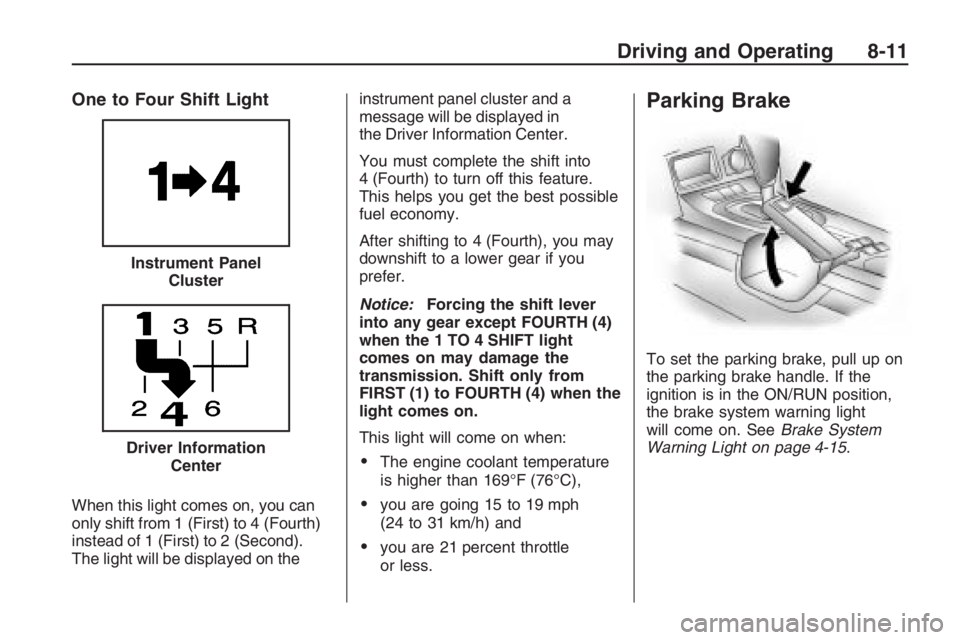
One to Four Shift Light
When this light comes on, you can
only shift from 1 (First) to 4 (Fourth)
instead of 1 (First) to 2 (Second).
The light will be displayed on theinstrument panel cluster and a
message will be displayed in
the Driver Information Center.
You must complete the shift into
4 (Fourth) to turn off this feature.
This helps you get the best possible
fuel economy.
After shifting to 4 (Fourth), you may
downshift to a lower gear if you
prefer.
Notice:Forcing the shift lever
into any gear except FOURTH (4)
when the 1 TO 4 SHIFT light
comes on may damage the
transmission. Shift only from
FIRST (1) to FOURTH (4) when the
light comes on.
This light will come on when:
The engine coolant temperature
is higher than 169°F (76°C),
you are going 15 to 19 mph
(24 to 31 km/h) and
you are 21 percent throttle
or less.
Parking Brake
To set the parking brake, pull up on
the parking brake handle. If the
ignition is in the ON/RUN position,
the brake system warning light
will come on. SeeBrake System
Warning Light on page 4-15. Instrument Panel
Cluster
Driver Information
Center
Driving and Operating 8-11
Page 195 of 356
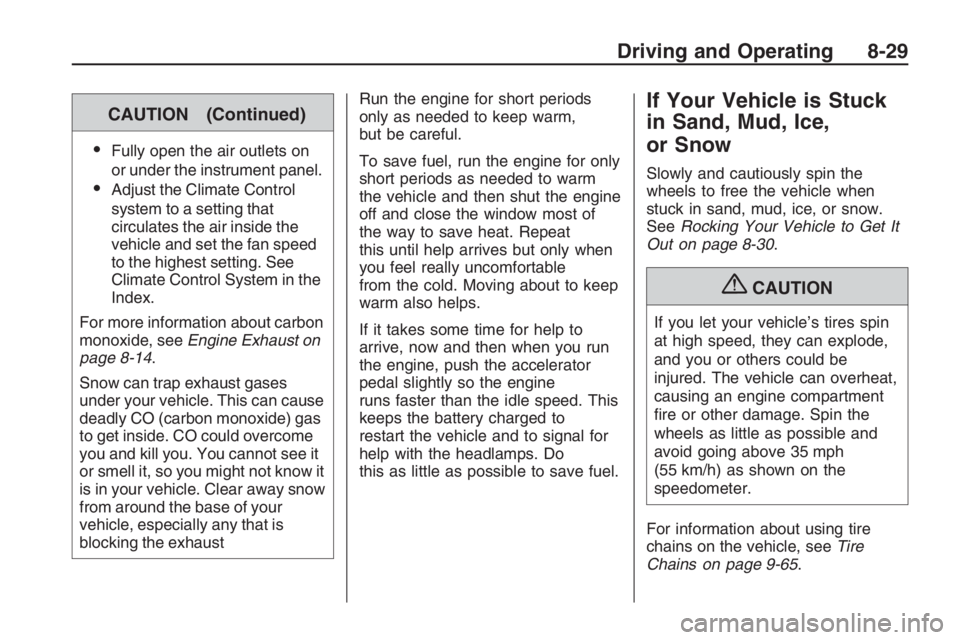
CAUTION (Continued)
Fully open the air outlets on
or under the instrument panel.
Adjust the Climate Control
system to a setting that
circulates the air inside the
vehicle and set the fan speed
to the highest setting. See
Climate Control System in the
Index.
For more information about carbon
monoxide, seeEngine Exhaust on
page 8-14.
Snow can trap exhaust gases
under your vehicle. This can cause
deadly CO (carbon monoxide) gas
to get inside. CO could overcome
you and kill you. You cannot see it
or smell it, so you might not know it
is in your vehicle. Clear away snow
from around the base of your
vehicle, especially any that is
blocking the exhaustRun the engine for short periods
only as needed to keep warm,
but be careful.
To save fuel, run the engine for only
short periods as needed to warm
the vehicle and then shut the engine
off and close the window most of
the way to save heat. Repeat
this until help arrives but only when
you feel really uncomfortable
from the cold. Moving about to keep
warm also helps.
If it takes some time for help to
arrive, now and then when you run
the engine, push the accelerator
pedal slightly so the engine
runs faster than the idle speed. This
keeps the battery charged to
restart the vehicle and to signal for
help with the headlamps. Do
this as little as possible to save fuel.
If Your Vehicle is Stuck
in Sand, Mud, Ice,
or Snow
Slowly and cautiously spin the
wheels to free the vehicle when
stuck in sand, mud, ice, or snow.
SeeRocking Your Vehicle to Get It
Out on page 8-30.
{CAUTION
If you let your vehicle’s tires spin
at high speed, they can explode,
and you or others could be
injured. The vehicle can overheat,
causing an engine compartment
�re or other damage. Spin the
wheels as little as possible and
avoid going above 35 mph
(55 km/h) as shown on the
speedometer.
For information about using tire
chains on the vehicle, seeTire
Chains on page 9-65.
Driving and Operating 8-29
Page 200 of 356
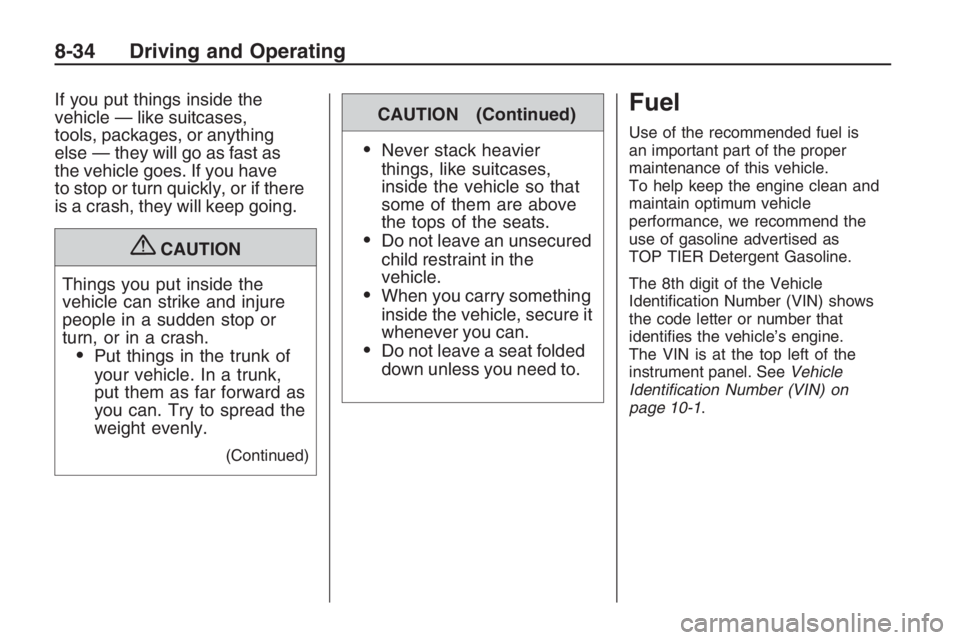
If you put things inside the
vehicle — like suitcases,
tools, packages, or anything
else — they will go as fast as
the vehicle goes. If you have
to stop or turn quickly, or if there
is a crash, they will keep going.
{CAUTION
Things you put inside the
vehicle can strike and injure
people in a sudden stop or
turn, or in a crash.
Put things in the trunk of
your vehicle. In a trunk,
put them as far forward as
you can. Try to spread the
weight evenly.
(Continued)
CAUTION (Continued)
Never stack heavier
things, like suitcases,
inside the vehicle so that
some of them are above
the tops of the seats.
Do not leave an unsecured
child restraint in the
vehicle.
When you carry something
inside the vehicle, secure it
whenever you can.
Do not leave a seat folded
down unless you need to.
Fuel
Use of the recommended fuel is
an important part of the proper
maintenance of this vehicle.
To help keep the engine clean and
maintain optimum vehicle
performance, we recommend the
use of gasoline advertised as
TOP TIER Detergent Gasoline.
The 8th digit of the Vehicle
Identi�cation Number (VIN) shows
the code letter or number that
identi�es the vehicle’s engine.
The VIN is at the top left of the
instrument panel. SeeVehicle
Identification Number (VIN) on
page 10-1.
8-34 Driving and Operating
Page 205 of 356
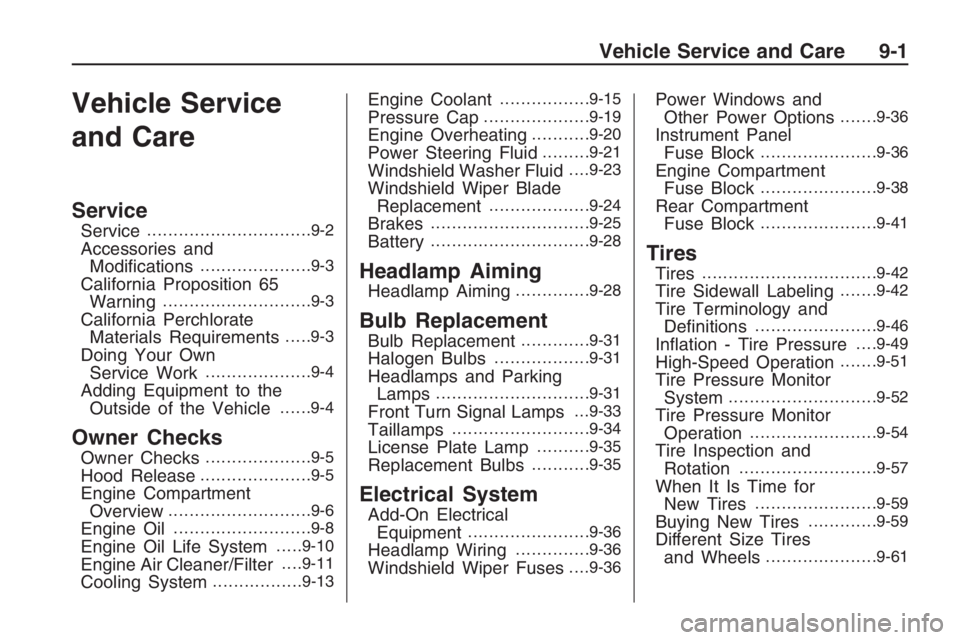
Vehicle Service
and Care
Service
Service...............................9-2
Accessories and
Modi�cations.....................9-3
California Proposition 65
Warning............................9-3
California Perchlorate
Materials Requirements.....9-3
Doing Your Own
Service Work....................9-4
Adding Equipment to the
Outside of the Vehicle......9-4
Owner Checks
Owner Checks....................9-5
Hood Release.....................9-5
Engine Compartment
Overview...........................9-6
Engine Oil..........................9-8
Engine Oil Life System.....9-10
Engine Air Cleaner/Filter. . . .9-11
Cooling System.................9-13
Engine Coolant.................9-15
Pressure Cap....................9-19
Engine Overheating...........9-20
Power Steering Fluid.........9-21
Windshield Washer Fluid. . . .9-23
Windshield Wiper Blade
Replacement...................9-24
Brakes..............................9-25
Battery..............................9-28
Headlamp Aiming
Headlamp Aiming..............9-28
Bulb Replacement
Bulb Replacement.............9-31
Halogen Bulbs..................9-31
Headlamps and Parking
Lamps.............................9-31
Front Turn Signal Lamps. . .9-33
Taillamps..........................9-34
License Plate Lamp..........9-35
Replacement Bulbs...........9-35
Electrical System
Add-On Electrical
Equipment.......................9-36
Headlamp Wiring..............9-36
Windshield Wiper Fuses. . . .9-36
Power Windows and
Other Power Options.......9-36
Instrument Panel
Fuse Block......................9-36
Engine Compartment
Fuse Block......................9-38
Rear Compartment
Fuse Block......................9-41
Tires
Tires.................................9-42
Tire Sidewall Labeling.......9-42
Tire Terminology and
De�nitions.......................9-46
In�ation - Tire Pressure. . . .9-49
High-Speed Operation.......9-51
Tire Pressure Monitor
System............................9-52
Tire Pressure Monitor
Operation........................9-54
Tire Inspection and
Rotation..........................9-57
When It Is Time for
New Tires.......................9-59
Buying New Tires.............9-59
Different Size Tires
and Wheels.....................9-61
Vehicle Service and Care 9-1
Page 209 of 356
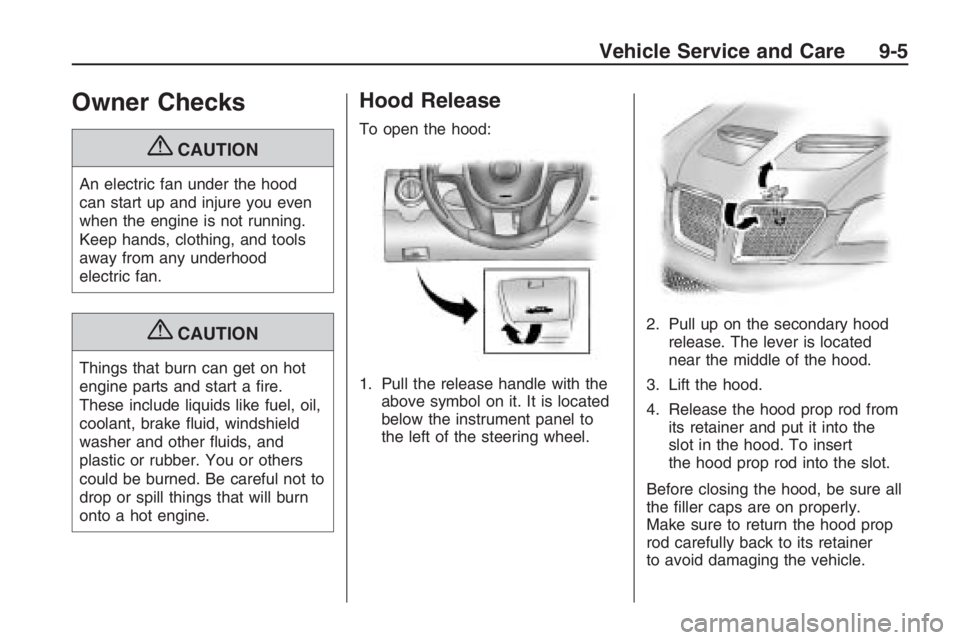
Owner Checks
{CAUTION
An electric fan under the hood
can start up and injure you even
when the engine is not running.
Keep hands, clothing, and tools
away from any underhood
electric fan.
{CAUTION
Things that burn can get on hot
engine parts and start a �re.
These include liquids like fuel, oil,
coolant, brake �uid, windshield
washer and other �uids, and
plastic or rubber. You or others
could be burned. Be careful not to
drop or spill things that will burn
onto a hot engine.
Hood Release
To open the hood:
1. Pull the release handle with the
above symbol on it. It is located
below the instrument panel to
the left of the steering wheel.2. Pull up on the secondary hood
release. The lever is located
near the middle of the hood.
3. Lift the hood.
4. Release the hood prop rod from
its retainer and put it into the
slot in the hood. To insert
the hood prop rod into the slot.
Before closing the hood, be sure all
the �ller caps are on properly.
Make sure to return the hood prop
rod carefully back to its retainer
to avoid damaging the vehicle.
Vehicle Service and Care 9-5
Page 224 of 356
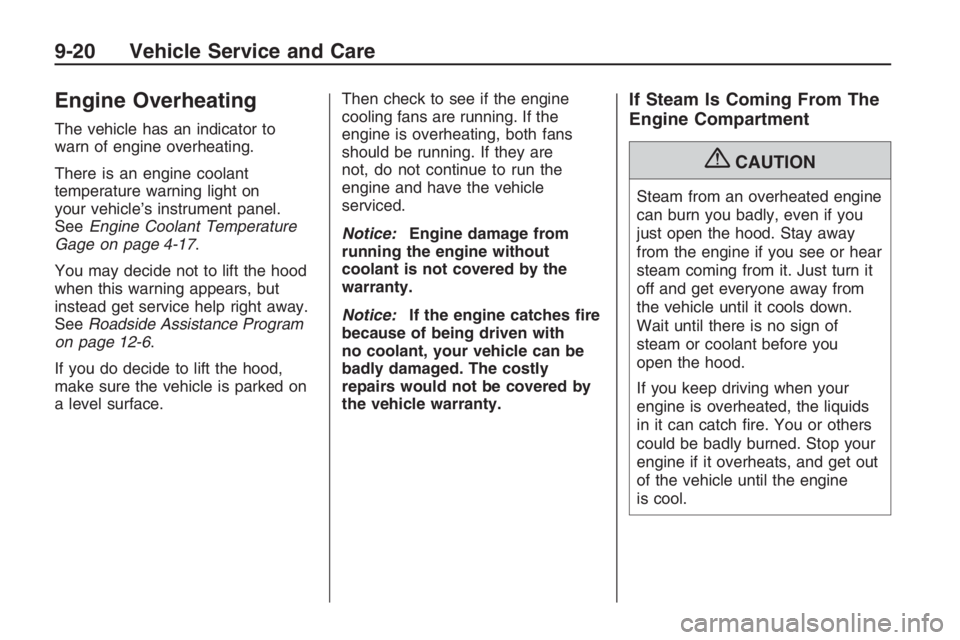
Engine Overheating
The vehicle has an indicator to
warn of engine overheating.
There is an engine coolant
temperature warning light on
your vehicle’s instrument panel.
SeeEngine Coolant Temperature
Gage on page 4-17.
You may decide not to lift the hood
when this warning appears, but
instead get service help right away.
SeeRoadside Assistance Program
on page 12-6.
If you do decide to lift the hood,
make sure the vehicle is parked on
a level surface.Then check to see if the engine
cooling fans are running. If the
engine is overheating, both fans
should be running. If they are
not, do not continue to run the
engine and have the vehicle
serviced.
Notice:Engine damage from
running the engine without
coolant is not covered by the
warranty.
Notice:If the engine catches �re
because of being driven with
no coolant, your vehicle can be
badly damaged. The costly
repairs would not be covered by
the vehicle warranty.
If Steam Is Coming From The
Engine Compartment
{CAUTION
Steam from an overheated engine
can burn you badly, even if you
just open the hood. Stay away
from the engine if you see or hear
steam coming from it. Just turn it
off and get everyone away from
the vehicle until it cools down.
Wait until there is no sign of
steam or coolant before you
open the hood.
If you keep driving when your
engine is overheated, the liquids
in it can catch �re. You or others
could be badly burned. Stop your
engine if it overheats, and get out
of the vehicle until the engine
is cool.
9-20 Vehicle Service and Care
Page 240 of 356
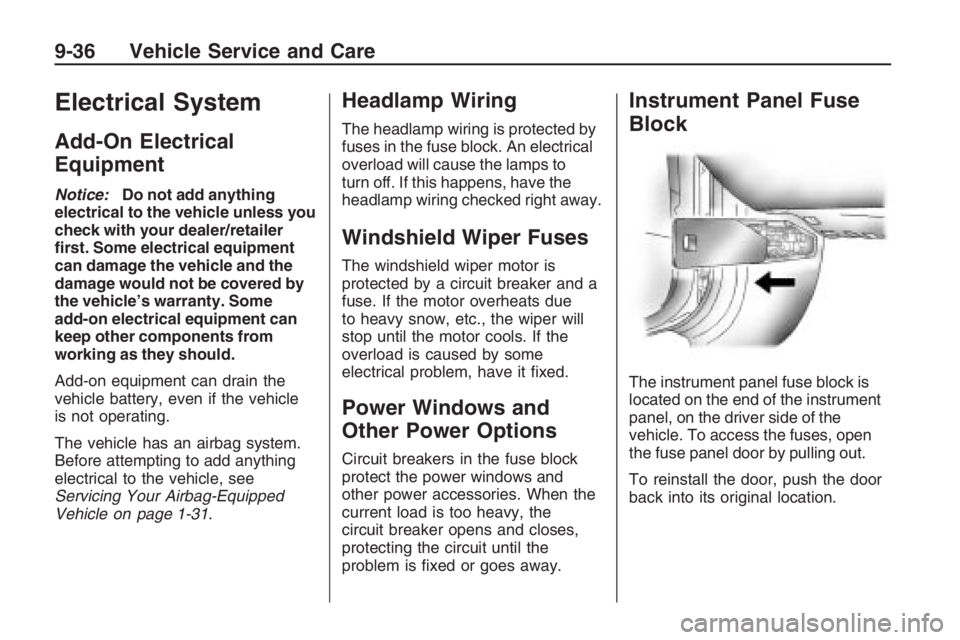
Electrical System
Add-On Electrical
Equipment
Notice:Do not add anything
electrical to the vehicle unless you
check with your dealer/retailer
�rst. Some electrical equipment
can damage the vehicle and the
damage would not be covered by
the vehicle’s warranty. Some
add-on electrical equipment can
keep other components from
working as they should.
Add-on equipment can drain the
vehicle battery, even if the vehicle
is not operating.
The vehicle has an airbag system.
Before attempting to add anything
electrical to the vehicle, see
Servicing Your Airbag-Equipped
Vehicle on page 1-31.
Headlamp Wiring
The headlamp wiring is protected by
fuses in the fuse block. An electrical
overload will cause the lamps to
turn off. If this happens, have the
headlamp wiring checked right away.
Windshield Wiper Fuses
The windshield wiper motor is
protected by a circuit breaker and a
fuse. If the motor overheats due
to heavy snow, etc., the wiper will
stop until the motor cools. If the
overload is caused by some
electrical problem, have it �xed.
Power Windows and
Other Power Options
Circuit breakers in the fuse block
protect the power windows and
other power accessories. When the
current load is too heavy, the
circuit breaker opens and closes,
protecting the circuit until the
problem is �xed or goes away.
Instrument Panel Fuse
Block
The instrument panel fuse block is
located on the end of the instrument
panel, on the driver side of the
vehicle. To access the fuses, open
the fuse panel door by pulling out.
To reinstall the door, push the door
back into its original location.
9-36 Vehicle Service and Care
Page 241 of 356
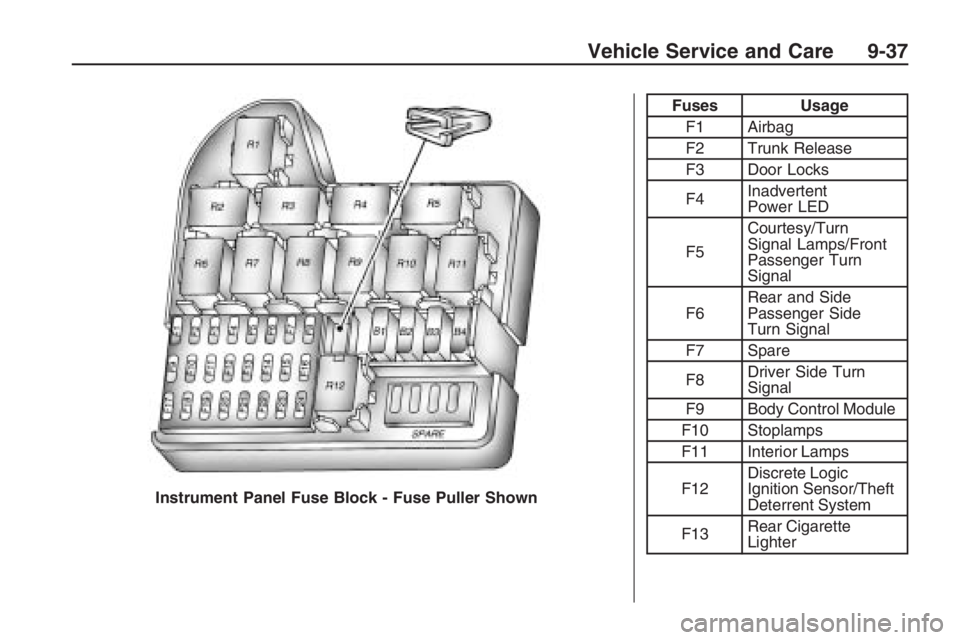
Fuses UsageF1 Airbag
F2 Trunk Release
F3 Door Locks
F4 Inadvertent
Power LED
F5 Courtesy/Turn
Signal Lamps/Front
Passenger Turn
Signal
F6 Rear and Side
Passenger Side
Turn Signal
F7 Spare
F8 Driver Side Turn
Signal
F9 Body Control Module
F10 Stoplamps
F11 Interior Lamps
F12 Discrete Logic
Ignition Sensor/Theft
Deterrent System
F13 Rear Cigarette
Lighter
Instrument Panel Fuse Block - Fuse Puller Shown
Vehicle Service and Care 9-37
Page 298 of 356
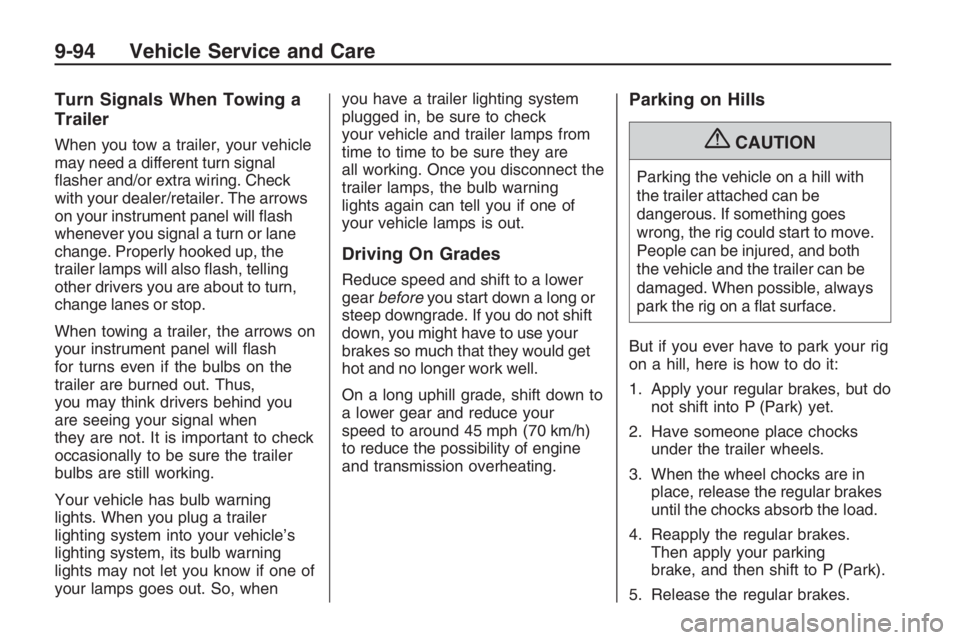
Turn Signals When Towing a
Trailer
When you tow a trailer, your vehicle
may need a different turn signal
�asher and/or extra wiring. Check
with your dealer/retailer. The arrows
on your instrument panel will �ash
whenever you signal a turn or lane
change. Properly hooked up, the
trailer lamps will also �ash, telling
other drivers you are about to turn,
change lanes or stop.
When towing a trailer, the arrows on
your instrument panel will �ash
for turns even if the bulbs on the
trailer are burned out. Thus,
you may think drivers behind you
are seeing your signal when
they are not. It is important to check
occasionally to be sure the trailer
bulbs are still working.
Your vehicle has bulb warning
lights. When you plug a trailer
lighting system into your vehicle’s
lighting system, its bulb warning
lights may not let you know if one of
your lamps goes out. So, whenyou have a trailer lighting system
plugged in, be sure to check
your vehicle and trailer lamps from
time to time to be sure they are
all working. Once you disconnect the
trailer lamps, the bulb warning
lights again can tell you if one of
your vehicle lamps is out.
Driving On Grades
Reduce speed and shift to a lower
gearbeforeyou start down a long or
steep downgrade. If you do not shift
down, you might have to use your
brakes so much that they would get
hot and no longer work well.
On a long uphill grade, shift down to
a lower gear and reduce your
speed to around 45 mph (70 km/h)
to reduce the possibility of engine
and transmission overheating.
Parking on Hills
{CAUTION
Parking the vehicle on a hill with
the trailer attached can be
dangerous. If something goes
wrong, the rig could start to move.
People can be injured, and both
the vehicle and the trailer can be
damaged. When possible, always
park the rig on a �at surface.
But if you ever have to park your rig
on a hill, here is how to do it:
1. Apply your regular brakes, but do
not shift into P (Park) yet.
2. Have someone place chocks
under the trailer wheels.
3. When the wheel chocks are in
place, release the regular brakes
until the chocks absorb the load.
4. Reapply the regular brakes.
Then apply your parking
brake, and then shift to P (Park).
5. Release the regular brakes.
9-94 Vehicle Service and Care
Page 302 of 356
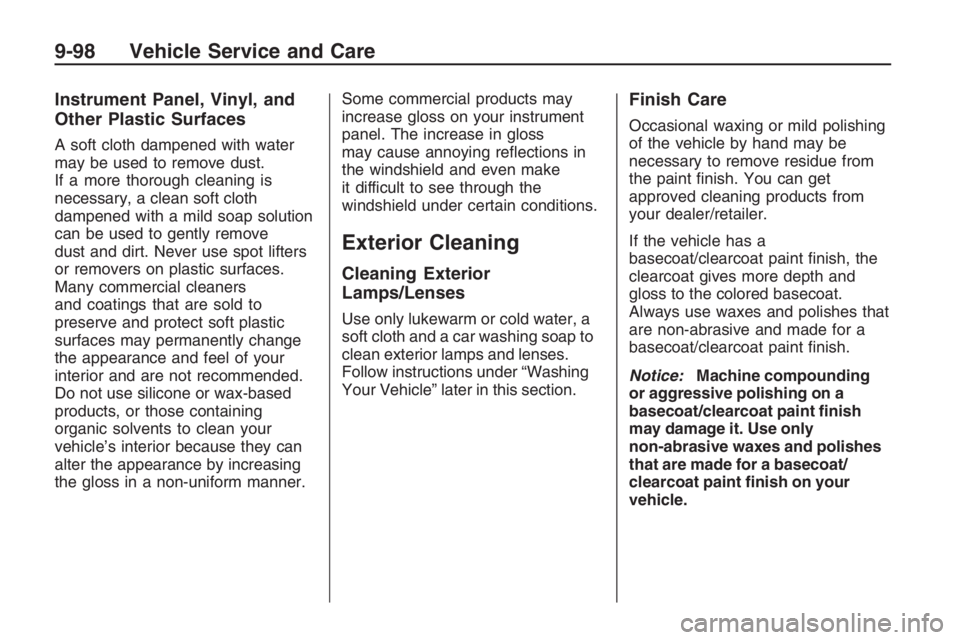
Instrument Panel, Vinyl, and
Other Plastic Surfaces
A soft cloth dampened with water
may be used to remove dust.
If a more thorough cleaning is
necessary, a clean soft cloth
dampened with a mild soap solution
can be used to gently remove
dust and dirt. Never use spot lifters
or removers on plastic surfaces.
Many commercial cleaners
and coatings that are sold to
preserve and protect soft plastic
surfaces may permanently change
the appearance and feel of your
interior and are not recommended.
Do not use silicone or wax-based
products, or those containing
organic solvents to clean your
vehicle’s interior because they can
alter the appearance by increasing
the gloss in a non-uniform manner.Some commercial products may
increase gloss on your instrument
panel. The increase in gloss
may cause annoying re�ections in
the windshield and even make
it difficult to see through the
windshield under certain conditions.
Exterior Cleaning
Cleaning Exterior
Lamps/Lenses
Use only lukewarm or cold water, a
soft cloth and a car washing soap to
clean exterior lamps and lenses.
Follow instructions under “Washing
Your Vehicle” later in this section.
Finish Care
Occasional waxing or mild polishing
of the vehicle by hand may be
necessary to remove residue from
the paint �nish. You can get
approved cleaning products from
your dealer/retailer.
If the vehicle has a
basecoat/clearcoat paint �nish, the
clearcoat gives more depth and
gloss to the colored basecoat.
Always use waxes and polishes that
are non-abrasive and made for a
basecoat/clearcoat paint �nish.
Notice:Machine compounding
or aggressive polishing on a
basecoat/clearcoat paint �nish
may damage it. Use only
non-abrasive waxes and polishes
that are made for a basecoat/
clearcoat paint �nish on your
vehicle.
9-98 Vehicle Service and Care